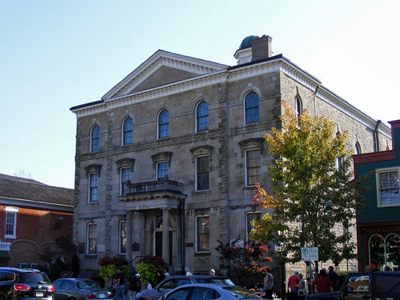Niagara District Court House National Historic Site of Canada
Niagara-on-the-Lake, Ontario

General view
© Old Niagara Court House, Sean Marshall, October, 2010.
Address :
26 Queen Street, Niagara-on-the-Lake, Ontario
Recognition Statute:
Historic Sites and Monuments Act (R.S.C., 1985, c. H-4)
Designation Date:
1981-01-15
Dates:
-
1846 to 1847
(Construction)
Event, Person, Organization:
-
William Thomas
(Architect)
Other Name(s):
-
Niagara District Court House
(Designation Name)
Plaque(s)
Existing plaque: 26 Queen Street, Niagara-on-the-Lake, Ontario
This is the third and only surviving court house erected for the former Niagara District. Constructed between 1846 and 1848, it was designed by the prominent Toronto architect, William Thomas, in the fashionable neoclassical style favoured for 19th century public buildings. It is an excellent example of a mid-19th century mulitpurpose civic structure. Though the courts were moved to nearby St. Catharines in 1862, this building has continued to play an important role in the life of this historic community, at one time as the town hall and latterly as the founding home of the Shaw Festival.
Description of Historic Place
Located on the main street of Niagara-on-the-Lake, the Niagara District Court House National Historic Site of Canada is a handsome stone building in a classical style. Its classicism is expressed through its symmetry and classical details, such as the central pediment, porch with columns, window surrounds, and stringcourses. The surviving interior spaces reflect the multiple uses for which this building was designed.
Heritage Value
The Niagara District Court House was designated a national historic site of Canada in 1980 because: designed by the prominent Toronto architect, William Thomas, in the fashionable Neoclassical style, it is an excellent example of a mid-19th century multipurpose civic structure.
The Niagara District Court House marks a step in the transition to large and more sophisticated civic buildings after 1850. Its greater scale resulted from the inclusion of a wide range of functions. In addition to the courtroom, offices and jail, the Niagara District Court House also included a town hall and market. The structure was designed by William Thomas, an architect of national standing, adept at several classical styles.
Sources: Historic Sites and Monuments Board of Canada, Submission Report, Minutes, 1980; Early Canadian Court Houses (Ottawa: Parks Canada, 1983).
Character-Defining Elements
Key elements contributing to the heritage value of this site include: its Neoclassical design, as expressed by its mass, symmetry, stone façade, and classical details, such as the corner quoins, pediment, stringcourses, and porch with columns; its complex of interior spaces, which support its original multifunctionalism; its surviving interior finishes; its close relationship with the main street of the town and with its neighbouring buildings.